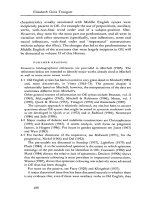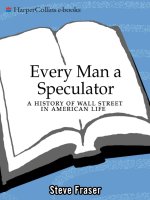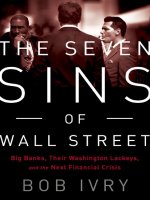Brown red blooded risk; the secret history of wall street (2012)
Bạn đang xem bản rút gọn của tài liệu. Xem và tải ngay bản đầy đủ của tài liệu tại đây (13.84 MB, 431 trang )
ffirs.indd ii
8/16/11 8:45:13 AM
Red-Blooded Risk
ffirs.indd i
8/16/11 8:45:12 AM
ffirs.indd ii
8/16/11 8:45:13 AM
Red-Blooded Risk
T H E S E C R E T H IS T O RY O F WA L L S T R E E T
Aaron Brown
John Wiley & Sons, Inc.
ffirs.indd iii
8/16/11 8:45:13 AM
Copyright © 2012 by Aaron Brown. All rights reserved.
Published by John Wiley & Sons, Inc., Hoboken, New Jersey.
Published simultaneously in Canada.
No part of this publication may be reproduced, stored in a retrieval system, or
transmitted in any form or by any means, electronic, mechanical, photocopying,
recording, scanning, or otherwise, except as permitted under Section 107
or 108 of the 1976 United States Copyright Act, without either the prior written
permission of the Publisher, or authorization through payment of the appropriate
per-copy fee to the Copyright Clearance Center, Inc., 222 Rosewood Drive,
Danvers, MA 01923, (978) 750-8400, fax (978) 646-8600, or on the Web at www
.copyright.com. Requests to the Publisher for permission should be addressed
to the Permissions Department, John Wiley & Sons, Inc., 111 River Street,
Hoboken, NJ 07030, (201) 748-6011, fax (201) 748-6008, or online at www
.wiley.com/go/permissions.
Limit of Liability/Disclaimer of Warranty: While the publisher and author have
used their best efforts in preparing this book, they make no representations or
warranties with respect to the accuracy or completeness of the contents of this
book and specifically disclaim any implied warranties of merchantability or fitness
for a particular purpose. No warranty may be created or extended by sales representatives or written sales materials. The advice and strategies contained herein
may not be suitable for your situation. You should consult with a professional
where appropriate. Neither the publisher nor author shall be liable for any loss
of profit or any other commercial damages, including but not limited to special,
incidental, consequential, or other damages.
For general information on our other products and services or for technical support, please contact our Customer Care Department within the United States at
(800) 762-2974, outside the United States at (317) 572-3993 or fax (317) 572-4002.
Wiley also publishes its books in a variety of electronic formats. Some content that
appears in print may not be available in electronic books. For more information
about Wiley products, visit our web site at www.wiley.com.
ISBN 978-1-118-04386-8 (cloth); 978-1-118-14015-4 (ebk); 978-1-118-14017-8 (ebk);
978-1-118-14016-1 (ebk)
Printed in the United States of America
10 9 8 7 6 5 4 3 2 1
ffirs.indd iv
8/16/11 8:45:13 AM
Contents
Acknowledgments
xi
Chapter 1
1
What This Book Is and Why You Should Read It
Risk, Danger, and Opportunity
2
Red-Blooded Risk Management
4
Risk and Life
7
Play and Money
9
Frequentism
11
Rationality
13
Bets
15
Exponentials and Culture
18
Payoff
20
Chapter 2
Red Blood and Blue Blood
23
Chapter 3
Pascal’s Wager and the Seven Principles of Risk Management
29
Principle I: Risk Duality
32
Principle II: Valuable Boundary
33
Principle III: Risk Ignition
35
Principle IV: Money
38
Outside the VaR Boundary
40
Principle V: Evolution
45
Principle VI: Superposition
48
Principle VII: Game Theory
49
v
ftoc.indd v
8/16/11 8:45:57 AM
vi
Contents
Chapter 4
Chapter 5
Chapter 6
ftoc.indd vi
The Secret History of Wall Street: 1654–1982
57
Pascal and Fermat
58
Poker
61
Advantage Gamblers
62
Sports Betting
63
Quants to Wall Street
66
Finance People
68
Real Finance
69
When Harry Met Kelly
73
Kelly
74
Harry
76
Commodity Futures
79
If Harry Knew Kelly
84
Investment Growth Theory
88
eRaider.com
92
MPT Out in the World
96
Exponentials, Vampires, Zombies, and Tulips
101
Types of Growth
102
The Negative Side
105
Tulips
106
Tulip Propaganda
108
Quantitative Tulip Modeling
111
Money
112
Chapter 7
Money
117
Chapter 8
The Story of Money: The Past
125
Property, Exchange, and Money
126
Paleonomics
128
Transition
131
What Money Does
134
Risk
135
Government and Paper
138
Paper versus Metal
142
1776 and All That
145
8/16/11 8:45:58 AM
Contents
Chapter 9
Andrew Dexter
147
A Short Digression into Politics and Religion
150
The Secret History of Wall Street: 1983–1987
155
Efficient Markets
157
Anomalies
159
The Price Is Right . . . Not!
161
Efficiency versus Equilibrium
162
Beating the Market
165
Paths
170
Sharpe Ratios and Wealth
174
1987
177
Chapter 10 The Story of Money: The Future
Farmers and Millers
ftoc.indd vii
vii
179
180
Money, New and Improved
183
A General Theory of Money
185
Value and Money
189
Numeraire
191
Clearinghouses
196
Cash
197
Derivative Money
200
The End of Paper
203
Chapter 11 Cold Blood
207
Chapter 12 What Does a Risk Manager Do?—Inside VaR
213
Professional Standards
213
Front Office
215
Trading Risk
217
Quants on the Job
218
Middle Office
222
Back Office
225
Middle Office Again
227
Looking Backward
228
Risk Control
230
Beyond Profit and Loss
232
8/16/11 8:45:58 AM
viii
Contents
Numbers
The Banks of the Charles
236
Waste
238
The Banks of the Potomac
241
The Summer of My Discontent
245
Validation
247
Chapter 13 VaR of the Jungle
251
Chapter 14 The Secret History of Wall Street: 1988–1992
255
Smile
256
Back to the Dissertation
258
Three Paths
262
An Unexpected Twist
265
Surprise!
267
Computing VaR
271
Chapter 15 Hot Blood and Thin Blood
277
Chapter 16 What Does a Risk Manager Do?—Outside VaR
283
Stress Tests
283
Trans-VaR Scenarios
287
Black Holes
289
Why Risk Managers Failed to Prevent the Financial Crisis
290
Managing Risk
296
Unspeakable Truth Number One: Risk Managers Should Make Sure Firms Fail
299
Unspeakable Truth Number Two: There’s Good Stuff beyond the VaR Limit
305
Unspeakable Truth Number Three: Risk Managers Create Risk
309
Chapter 17 The Story of Risk
313
Chapter 18 Frequency versus Degree of Belief
323
Statistical Games
ftoc.indd viii
234
324
Thorp, Black, Scholes, and Merton
329
Change of Numeraire
333
Polling
336
The Quant Revolution
341
8/16/11 8:45:58 AM
Contents
Chapter 19 The Secret History of Wall Street: 1993–2007
Where Did the Money Come From?
ftoc.indd ix
ix
345
348
Where Did They Put the Money?
359
Where Did the Money Go?
364
Chapter 20 The Secret History of Wall Street: The 2007 Crisis and Beyond
369
Postmortem
379
A Risk Management Curriculum
387
One Hundred Useful Books
393
About the Author
401
About the Illustrator
403
Index
405
8/16/11 8:45:58 AM
ftoc.indd x
8/16/11 8:45:58 AM
Acknowledgments
T
he ideas presented in this book are the fruit of an informal collaboration of mathematically inclined researchers who became
obsessed with the idea of betting—real bets for significant stakes
versus all comers—on the results of their analyses. It is difficult to
assign individual credit in a collaboration, and in any case there
were too many participants to list here, even if I knew all of them.
So I will take the easy way out and dedicate this book to anyone who
ever made computations, bet on them, and learned enough from
the experience to become successful.
More specifically, I acknowledge the tremendous benefit I have
from arguing over these ideas in several places. I thank my colleagues
at the various financial institutions I have worked for, and participants
in risk conferences over the years, including those run by the Global
Association of Risk Professionals, the Professional Risk Managers
International Association, Risk magazine, and others. A special mention goes to the triennial conferences on gambling and risk taking produced by the University of Nevada at Reno, which attract a far broader
variety of participants than the other conferences.
I also had the benefit of discussing these ideas at online sites,
including Wilmott.com, NuclearPhynance.com, QuantNet.com,
and TwoPlusTwo.com. And speaking of Internet sites, everyone connected with eRaider.com helped forge my ideas.
It is a little weird to dedicate a book to fictional characters, especially ones the author made up himself. But Red Blood, Blue Blood,
Cold Blood, Thin Blood, Hot Blood, Unblooded, and Blood Sucker
are composites of real people I have worked with over the years. So
I acknowledge here my debt to the dozens of people who provided
slices of various characters’ history and attitudes.
Many people read part or all of the manuscript and sent useful comments. Brandon Adams, Gustavo Bamberger, Bill Benter, John Bogle, Rick
Bookstaber, Reuven Brenner, Eugene Christiansen, Emanuel Derman,
xi
flast.indd xi
8/16/11 8:45:36 AM
xii
Acknowledgments
Art Duquette, Dylan Evans, Doyne Farmer, Justin Fox, Kenneth French,
Lisa Goldberg, James Grosjean, Ian Hacking, Michael Heneberry, Carey
Hobbs, Craig Howe, James McManus, Michael Maubossin, Nick Maughan,
Perry Mehrling, Robert Merton, Joe Nocera, John O’Brien, Deborah
Pastor, Scott Patterson, William Poundstone, Kevin Rosema, Myron
Scholes, James Stoner, Nassim Taleb, Edward Thorp, Whitney Tilson,
James Ward, Paul Wilmott, and Bruce Zastera were particularly helpful.
The title comes from my daughter, Aviva Pastor. Tiffany Charbonier, Bill
Falloon, Stacey Fischkelta, Meg Freeborn, Sharon Polese, and other folks
at John Wiley & Sons provided essential feedback and support.
Muhammad Cohen edited every word I wrote, and I rarely overrode his corrections. This book is far more readable for his efforts.
Eric Kim provided the drawings. He is a true manga artist, not an
illustrator for hire, and the give-and-take we went through added
tremendously to the content.
My family, Deborah, Jacob, and Aviva, provided helpful advice
and support throughout the process.
flast.indd xii
8/16/11 8:45:36 AM
Red-Blooded Risk
flast.indd xiii
8/16/11 8:45:36 AM
flast.indd xiv
8/16/11 8:45:36 AM
1
C H A P T E R
What This Book Is and Why
You Should Read It
L
ife is full of choices. At a job interview, you can give short, pleasant answers to questions. Or you can burst into an impassioned
rant about how you will add value to the enterprise. You can dress
sedately and behave discretely at a party, or go for maximum drama
in your clothes and demeanor. In a basketball game you can throw
up a quick shot, or pass the ball so the team can work into position
for a higher-percentage shot. You can walk on by an interestinglooking stranger, or throw out a remark or a wink. These choices all
concern risk.
In the basketball example, you have a coach. When the team
is ahead late in the game, the coach will give one kind of advice.
On offense, take plenty of time and get a high-percentage shot. On
defense, deny the opponents easy shots and do not foul. Why?
Because this style of play minimizes the variance of outcome, which
is to the advantage of the team in the lead. The trailing team will
try to shoot three-point shots quickly and will play aggressively for
steals and blocks on defense. They don’t mind fouls because those
can change the score without running time off the clock. They are
trying to maximize variance of outcome.
If you’re not familiar with basketball, the same idea applies in virtually every competitive sport. The player or team that is ahead wants
to minimize risk, whereas the opposing player or team wants to maximize it. In baseball, a pitcher with a lead throws strikes; when his
team is trailing he will work the corners and throw off-speed pitches.
1
c01.indd 1
8/16/11 8:33:58 AM
2
Red-Blooded Risk
In soccer with a lead you try to control the ball and keep your
defense back; when behind you attack aggressively. In hockey, the
trailing team will sometimes even pull the goalkeeper. In American
football, the team with the lead will run the ball up the middle and
play prevent defenses, while the other team blitzes and throws long
passes.
In the job interview, the short, safe answers are indicated if you
think you’re likely to get the job and just don’t want to blow it. But
if you’re a long shot to be hired, maybe it’s time to dust off that
rant. Going to an obligatory party for your job, one you know will
be boring? Navy suit, say as little as possible and only about the
weather, don’t drink, and leave early. But if you want to be the life
of the party, have a great time, and maybe change your life? Think
hot pink. And before you wink at the stranger, ask yourself if you’re
a bit bored and looking for new adventures—or is your life exciting and complicated enough already and you need peace and quiet
more than a new friend?
Risk is something you dial up or down in order to accomplish a
goal. It is neither good nor bad in itself. This is the sense in which
I always use the word risk in this book. Compare this to the “risk”
of a basketball player getting injured. I will use the word danger for
this, not risk. Dangers should be minimized, subject to constraints.
For example, we don’t want to require so much protective padding
that a game is not fun, or the cost is too great. So we don’t try to set
danger of injury to zero, but we also don’t “manage” it; we never
increase it for its own sake.
The counterpart to a danger on the good side is an “opportunity,” such as the opportunity for a pitcher in baseball to get a
no-hitter. This is considered so valuable that a manager will almost
always leave a pitcher with a chance at a no-hitter in the game, even
if he is tiring and a relief pitcher would increase the probability of
winning the game.
Risk, Danger, and Opportunity
There are three tests to determine if something is a risk rather than
a danger or an opportunity:
1. Risks are two-sided; you can win or you can lose. Dangers and
opportunities are one-sided. If you have a sudden change of
c01.indd 2
8/16/11 8:33:58 AM
What This Book Is and Why You Should Read It
3
health while playing football, it is highly unlikely to be an
improvement.
2. Dangers and opportunities are often not measurable, and if
they are, they are measured in different units than we use for
everyday decisions. We can’t say how many points a broken
collarbone is worth, or whether two sprained ankles are better or worse than a broken finger. There is no dollar figure to
put on the glory of setting a record or winning a championship. Risks, however, are measurable. In order to manage an
uncertainty, we need some way of assigning relative values to
gains and losses.
3. Dangers and opportunities often come from nature, and we
usually have only limited ability to control them. Risks always
refer to human interactions, and
their level must be under our
control—if not, they may
be risks to somebody
else but they are facts
of life to us.
The distinction is not
inherent in the uncertainties themselves; it is our
choice how to treat them.
For example, NASCAR has
been accused of manipulating its rules to get an optimal
number of fatal crashes per year:
enough to keep a dangerous, outlaw edge but not so many as to kill all
the popular drivers or provoke safety
legislation. I have no opinion on whether this charge is true or
false. If true, it means NASCAR is treating as a risk something that
most people consider a danger. That might be immoral, but it is
not illogical or irrational.
Some job applicants treat every question as a danger, carefully
probing for traps and giving minimal answers to avoid the chance
of mistake. They seldom get hired. Others treat every question as an
opportunity to posture or boast. They never get hired. Some people
go to parties that should be fun, and dress and act more appropriately
c01.indd 3
8/16/11 8:33:58 AM
4
Red-Blooded Risk
for a funeral, letting the danger of embarrassing themselves overwhelm rational consideration of risk. Other people treat funerals as
parties, grasping for opportunities that do not exist.
Another example of mixing up risk and danger is a famous
memorandum by Ford Motor Company concluding that the cost to
the company of settling lawsuits for Pinto owners burned to death
in low-speed rear collisions was less than the $10 per car it would
cost to shield the gas tank. This story, although widely believed, is a
distortion of the facts, and Ford is innocent of any such decision. I
mention it only to emphasize that the distinction between risks and
dangers is in the eye of the beholder.
There are also things we can choose to treat as risks or opportunities. In On the Waterfront, protagonist Terry Malloy makes the famous
lament, “I coulda had class. I coulda been a contender. I coulda been
somebody, instead of a bum, which is what I am,” blaming his brother
for persuading him to purposely lose a boxing match for the sure thing
“short-end money.” He is not complaining that there was not enough
short-end money, but that he sold something that was literally priceless. His brother treated his opportunity like a risk, and managed it.
A coward treats risks as dangers, whereas a thrill seeker treats
them as opportunities. We call them thin-blooded and hot-blooded,
respectively. A cold-blooded person treats both dangers and opportunities as risks. Red-blooded refers to people who are excited by
challenges, but not to the point of being blinded to dangers and
opportunities. To keep this straight, think of the classic movie plot
in which the red-blooded hero and his hot-blooded sidekick push
aside the thin-blooded person in charge, to fight the cold-blooded
villain. We admire the first two people in different ways, feel sorry
for the third, and hate the fourth.
Red-Blooded Risk Management
In emotional terms, thin-blooded people are motivated mainly by
fear, hot-blooded people by anger and other passions—or even
merely thrills—and cold-blooded people by greed. Red-blooded
people feel anger and fear and greed like anyone else, but understand successful risk taking is a matter of calculation, not instinct.
This is not a self-help book. I do not have any advice for how to
achieve this psychological state, if that is what you want to do. What
I can tell you is how to compute the red-blooded action in risk situations. It’s mathematics, not psychology. Red-blooded risk management
c01.indd 4
8/16/11 8:33:59 AM
What This Book Is and Why You Should Read It
5
consists of three specific mathematical techniques, which have been
thoroughly tested in real-world applications. Although quantitative
skills are required to implement them, the ideas are simple and will
be explained in this book without math. The techniques are used to:
• Turn any situation into a system with clearly delineated risks,
dangers, and opportunities.
• Optimize the risks for the best possible outcome.
• Arrange things so both dangers and opportunities make the
maximum positive contributions.
This field was invented by a cohort of quantitatively trained risk
takers born in the 1950s. In the 1970s, we rebelled against conventional academic and institutional ideas of risk. We sought wisdom
from actual risk-takers, which took us to some disreputable places.
In the 1980s, we found ourselves taking risks on Wall Street, and
developed the ideas described in this book between 1987 and 1992,
although of course most of the ideas can be traced to much earlier
work. University of Chicago economics professor Frank Knight, for
example, made a distinction between risk, with known probabilities and outcomes, and uncertainty, which is something akin to our
dangers and opportunities. But he did this to emphasize the limits
of mathematics in decision making under uncertainty. He did not
appreciate the power of quantitative methods for separating risk
from uncertainty, nor the tremendous benefit from applying mathematics to optimize risk taking. Most important, he failed to see that
mathematics can be brought to bear just as fruitfully on nonquantifiable uncertainty as on risk. Knight was a deeper thinker than any
of the Wall Street risk takers, but we had far more experience in
making successful quantitative risk choices.
This group of risk-taking rebels became known as “rocket scientists.” That was partly because several of us actually worked on
rockets (I myself spent a summer on satellite positioning, which
technically uses rockets, but not the big ones that lift payloads into
space; anyway, my contribution was entirely mathematical. I never
saw an actual rocket firing except on film, so the experience certainly doesn’t make me a real rocket scientist.), but mostly to capture
the combination of intense and rigorous mathematical analysis tied
firmly to physical reality, exploration, and adventure. Recall that
one of our generation’s defining moments was the Apollo moon
landing. We weren’t astrophysicists and we weren’t engineers. We
c01.indd 5
8/16/11 8:33:59 AM
6
Red-Blooded Risk
didn’t know exactly what we were, but we knew it was something
in between. A more general term for people who use quantitative
methods in finance is “quant,” but that term also describes less
rebellious researchers with quantitative training who came to Wall
Street later and called themselves “financial engineers.”
I am aware that “rocket scientist” is a stupid name, both boastful
and inaccurate. I didn’t make it up, and don’t use it much. I describe
myself as a “quant” with a lowercase q, unpretentious as in, “just a
simple quant.” I’m not humble, as you’ll figure out if you keep reading, but I’m not given to overstatement. What I do isn’t rocket science, most of it is trivially simple and the rest is more meticulous
care than brilliance. But to be historically accurate, we’re stuck with
the term, and it does convey some of the spirit of the group.
We contrasted ourselves to people we called “Einsteins,” an
even stupider name. We had nothing against Albert Einstein, but
we disagreed with people who thought risk was deeply complex and
could be figured out by pure brainpower, without actually taking
any risk or observing any risk takers. “Einstein” was rarely used as a
noun. It was more common as an adjective. “He had a good insight,
but went Einstein with it,” or “He used to be a rocket scientist but
got offered a tenure track position and went Einstein.” Don’t blame
me. I don’t defend the usages, I just report them.
The rocket scientists rebuilt the financial system from the
ground up. I compare these changes to the differences between
a modern digital camera and a point-and-shoot film camera from
1980. They look similar. They both have lenses and flashes and shutter buttons. They both run on batteries, in some cases the same batteries. They are used to take pictures of vacations and parties and
family members. They cost about the same. From the standpoint of
sellers and users, the difference seems to be just an improvement in
technology for the same basic device.
But for someone making cameras, there is no similarity at all.
The modern technology is built on entirely different principles
from the old one. From 1982 to 1992 rocket scientists hollowed out
the inside of Wall Street and rebuilt it. We didn’t set out to do that;
it just happened. Most people, including most people working on
Wall Street, didn’t notice the fundamental change. They saw some
of the minor external design changes, and noticed one day there
was no more film to develop, but missed that something unprecedented in history had been created.
c01.indd 6
8/16/11 8:33:59 AM
What This Book Is and Why You Should Read It
7
At the same time, with even less intention, we figured out the
350-year-old riddle at the heart of probability theory. As has always
been the case with probability, practitioners ran ahead of theory.
No doubt we will someday have a coherent theoretical explanation
of how modern financial risk management works. Until then, all I
can do is show you how and why it came into being, and what it is
doing to the world.
Risk and Life
Risk taking is not just a quantitative discipline, it is a philosophy of
life. There are basically two sensible attitudes about risk. The first is
to avoid it whenever possible, unless there is some potential payoff
worth the risk. The second is to embrace risk taking opportunities
that appear to offer a positive edge. The advantage of the second
course is that you take enough gambles that the outcome of any
one, or any ten or hundred, doesn’t matter. In the long run, you
will end up near your expected outcome, like someone flipping a
coin a million times.
In my experience, people incline to one of these two strategies
early in life. Perhaps it’s in our genes. In this context, I always think
of a highway sign you can see if you drive from Nice to Monte Carlo.
There is a fork, and the sign points right to “Nice Gene” and left
to “Monte Carlo Gene.” On that choice, I’m a leftist. That doesn’t
mean I take huge risks; it means I take lots of risks. I have learned
from others and invented myself ways to balance these to ensure
a good outcome, insomuch as mathematics and human efforts can
ensure anything.
There are three iron rules for risk takers. Since your plan is to
arrive at an outcome near expectation, you must be sure that expectation is positive. In other words, you must have an edge in all your
bets. Expectation is only an abstraction for risk-avoiders. If you buy
a single $1 lottery ticket, it makes no practical difference whether
your expected payout is $0.90 or $1.10. You’ll either hit a prize or
you won’t. But if you buy a million tickets, it makes all the difference in the world.
Second, you need to be sure you’re not making the same bets
over and over. Your bets must be as independent as possible. That
means you cannot rely on systems or superstitions, not even on
logic and rationality. These things will lead you to make correlated
c01.indd 7
8/16/11 8:33:59 AM
8
Red-Blooded Risk
bets. You must search hard for new things to bet on, unrelated to
prior bets, and you must avoid any habits. In many cases you find
it advantageous to make random decisions, to flip coins. For risk
avoiders taking only a few big chances, correlation is a secondary
concern and flipping a coin for a decision makes no sense.
Finally, risk takers must size their bets properly. You can never
lose so much that you’re taken out of the game; but you have to be
willing to bet very big when the right gambles come along. For a
risk avoider, being taken out of the game is no tragedy, as risk taking was never a major part of the life plan anyway. And there’s no
need to bet larger than necessary, as you are pursuing plans that
should work out if nothing bad happens, you’re not counting on
risky payoffs to succeed.
While moderation is often a good strategy, I don’t think you
can choose a middle way between risk avoiding and risk taking.
Consider an investment portfolio. You can invest in high-quality
bonds with payoffs selected near the times you expect to need the
money, and possibly hedge your bets further by buying hard assets.
Or you can buy stocks and hope for the best. If you choose the latter route, the risk-taking approach, you should seek out as many
sources of investment risk as you think the market compensates—
that is, all the securities for which there is a positive edge. Both
strategies make sense, but it’s crazy to split the difference by buying
only one stock. You either avoid risk as much as practical, or you try
to find as many risks as you can.
You could, of course, put half your portfolio in bonds and the
other half in diversified risky assets, but this still makes you a risk
taker, seeking out as many risks as possible. You just run a low risk version of the strategy. There’s nothing that says a risk taker has to have
a high-risk life. In practice, however, once investors take all the trouble to create a broadly diversified portfolio, or individuals learn to
embrace risk, they tend to exploit the investment.
It’s good that people make this choice young, because each route
requires skills and life attitudes that would be fatal to acquire playing for adult stakes. Risk takers must enjoy the volatility of the ride,
because that’s all there is. There is no destination. You never stop
gambling. Risk avoiders must learn to endure volatility in order to get
to the planned destination. The world needs both kinds of people.
If you are a risk taker, you need the material in this book to survive, assuming you haven’t already figured it out for yourself. We
c01.indd 8
8/16/11 8:34:00 AM
What This Book Is and Why You Should Read It
9
know a lot about the mathematics of risk taking that no one in the
world knew a quarter century ago. If you are not a risk taker, you
should still understand the mathematics of risk due to its effect on
the world.
Quantitative risk models from Wall Street are in considerable
disrepute at the moment. I hope to convince you that attitude is
wrong. Whether or not I do, I can tell you that these models have
changed the world completely, and the pace of that change will
only accelerate. So even if you think they are worthless or harmful,
it’s worth understanding them.
Play and Money
I’m going to cover some topics you might not expect in a book
on risk. First is play. One of the characteristics of play is that it
takes place within a delineated area—physical or mental—which
is not allowed to interact with the rest of the world. Basketball,
for example, takes place on a court with clearly defined physical
boundaries—and has people to blow whistles if the ball goes beyond
those boundaries, stopping play until the situation is rectified. You
are not allowed to buy a basket for money or any other consideration outside the perimeter of the game. Whether two players like
or dislike each other is supposed to be irrelevant; their actions
depend only on whether they’re on the same team or on opposing teams. This is what allows us to treat the in-game events as risks.
When the outside world intrudes, as with an injury or an equipment
failure, those events cannot be managed as risks, because by rule
they are incommensurate with baskets.
Although the world is not supposed to intrude on play, play can
have enormous effect on the world. Elections, trials, and some wars are
contests governed by rules that occur in designated times and places.
Market competition can be considered a game, and game theory is a
major part of the study of economics. Less serious games constitute
a large portion of the economy: sports, gambling, video games, hobbies, and many other activities represent sizable aggregate demand for
products and services. We will look deeply into these matters because
risk management depends on the kind of delineation and isolation
required by play. In a deep sense, risk is play and play is risk.
We’re also going to discuss money. When economists consider risk,
they usually assume that the types of stakes don’t matter—gambling
c01.indd 9
8/16/11 8:34:00 AM









